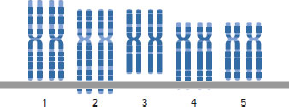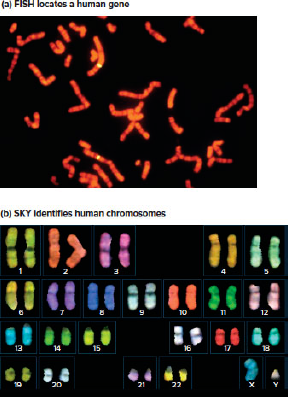
Genetics: From Genes to Genomes
6th Edition
ISBN: 9781259700903
Author: Leland Hartwell Dr., Michael L. Goldberg Professor Dr., Janice Fischer, Leroy Hood Dr.
Publisher: McGraw-Hill Education
expand_more
expand_more
format_list_bulleted
Concept explainers
Textbook Question
Chapter 12, Problem 9P
Suppose you performed a fluorescence in situ hybridization experiment (FISH) on chromosomes from a human cell using a probe corresponding to a gene located near (but not at) the telomere of the q arm of chromosome 4.
| a. | On the following idiogram, which shows only chromosomes 1–5 contained in this diploid cell, indicate the location of all fluorescent signals. |

| b. | Compare your idiogram with the result of the FISH experiment shown in Fig. 12.9a. Why are the chromosomes scattered in Fig. 12.9a, rather than being present in neatly arranged pairs of homologous chromosomes as in the idiogram? Do you think it is likely that the gene whose DNA was used as a probe in Fig. 12.9a is found on the q arm of human chromosome 21? |

Expert Solution & Answer
Want to see the full answer?
Check out a sample textbook solution
Students have asked these similar questions
What are functions of cuboidal cells in the kidney? Select all that apply.
Concentration of gases
Dilution of chemicals
Secretion of molecules
Nutrition to tissues
Support of tissues
Absorption of molecules
question1 In plants, epithelial tissue is only found as the outermost cell layer and acts as a barrier. In humans, epithelial tissue is found inside the body as well as on the surface.
What function(s) does/do epithelial tissue carry out in humans? Select all that apply.
Waste storage
Filtration
Oxygen transport
Protection
Diffusion
Osmosis
Absorption
What words best describes this organism?
a. Unicellular/nonmotile
Ob. unicellular/motile
c. colonial/nonmotile
d. colonial/motile
e. multicelluar
O f. siphonous
g. none of these
Chapter 12 Solutions
Genetics: From Genes to Genomes
Ch. 12 - For each of the terms in the left column, choose...Ch. 12 - Many proteins other than histones are found...Ch. 12 - What difference exists between the compaction of...Ch. 12 - What is the role of the core histones in...Ch. 12 - a. About how many molecules of histone H2A would...Ch. 12 - The enzyme micrococcal nuclease can cleave...Ch. 12 - a. What letters are used to represent the short...Ch. 12 - About 2000 G bands are visible in a...Ch. 12 - Suppose you performed a fluorescence in situ...Ch. 12 - Which of the following would be suggested by a...
Ch. 12 - For each of the following pairs of chromatin...Ch. 12 - a. Drosophila b. Humans Give examples of...Ch. 12 - One histone modification that is seen consistently...Ch. 12 - Recently, scientists constructed a transgene that...Ch. 12 - Drosophila geneticists have isolated many...Ch. 12 - On the following figures, genes A and B are on the...Ch. 12 - Prob. 17PCh. 12 - The first page of this chapter displays photos of...Ch. 12 - The human genome contains about 3 billion base...Ch. 12 - The mitotic cell divisions in the early embryo of...Ch. 12 - In an experiment published in the journal Cell in...Ch. 12 - a. What DNA sequences are found at the telomeres...Ch. 12 - Prob. 23PCh. 12 - a. In a fluorescent in situ hybridization FISH...Ch. 12 - If you are comparing the two telomeres in each...Ch. 12 - a. What DNA sequences are commonly found at human...Ch. 12 - On the graphs presented in Problem 21, no data is...Ch. 12 - Prob. 29PCh. 12 - Prob. 30PCh. 12 - In the 1920s, Barbara McClintock, later a Nobel...Ch. 12 - Give at least one example of a chromosomal...Ch. 12 - Cornelia de Lange syndrome CdLS is a rare human...Ch. 12 - a. Give at least three examples of types of...Ch. 12 - A number of yeast-derived elements were added to...Ch. 12 - Prob. 36PCh. 12 - The completely synthetic yeast chromosome Syn III...
Knowledge Booster
Learn more about
Need a deep-dive on the concept behind this application? Look no further. Learn more about this topic, biology and related others by exploring similar questions and additional content below.Similar questions
- Identify the phylum or class. a. Euglenophyta b. Dinoflagellata c. Bacillariophyceae d. Oomycetes e. Phaeophyceae O f. Myxomycota g. Xanthophyceae ○ h. Chrysophyceae i. Dictyosteliomycota O j. Rhodophyta Ok. Chlorophyceaens I. Charophyceaensarrow_forwardWhat is produced inside the indicated structure (Fucus). a. eggs O b. antheridia ○ c. sperm d. zygotes e. none of thesearrow_forwardGreen Algae, as a group, is actually paraphyletic with one subgroup more closely related to higher plants than the other. Which of the following green algae groups is more closely related to higher plants: a. Charophyceans b. Chlorophyceans c. Rhodophyta d. Xanthophyceansarrow_forward
- A single-celled green algal genus that is motile with 2 flagella, has a cup shaped chloroplast, and an eyespot: a. Volvox b. Chlamydomonas c. Euglena d. Codiumarrow_forwardA[n] ___ is produced by members of the Myxomycota when there is a lack of moisture. a. plasmodiocarp b. aethalium c. sclerotium d. plasmodiumarrow_forwardWhich of the following is not true about the life-cycle of Fucus. a. 8 eggs per oogonium b. 64 sperm per antheridium c. eggs are flagellated d. sperm are flagellatedarrow_forward
- Green Algae, as a group, is actually paraphyletic with one subgroup more closely related to higher plants than the other. Which of the following green algae groups is more closely related to higher plants: a. Charophyceans b. Chlorophyceans c. Rhodophyta d. Xanthophyceansarrow_forwardCertain toxic terpenoids in this group is thought to deter herbivory but may also have some anti-tumor activity? a. green algae b. brown algae c. red algae d. golden algae e. none of thesearrow_forwardIn the cellular slime molds, the most common phase is: a. plasmodium b. pseudoplasmodial c. single cells as myxamoebae d. moundingarrow_forward
- Which of the following descriptive terms does not describe Hydrodictyon? a. colonial b. nonmotile c. 1 large reticulated chloroplast in each cell d. all of these describe Hydrodictyonarrow_forwardWhich of the following does not apply to Chara? a. "stoneworts" b. isogamous c. calcified walls d. apical growth with an axis and branchesarrow_forwardtell us about one time when you went the extra mile when it would be acceptable to perform the bare minimum. why did you exert the extra effort and what was the outcome?arrow_forward
arrow_back_ios
SEE MORE QUESTIONS
arrow_forward_ios
Recommended textbooks for you
 Biology: The Dynamic Science (MindTap Course List)BiologyISBN:9781305389892Author:Peter J. Russell, Paul E. Hertz, Beverly McMillanPublisher:Cengage Learning
Biology: The Dynamic Science (MindTap Course List)BiologyISBN:9781305389892Author:Peter J. Russell, Paul E. Hertz, Beverly McMillanPublisher:Cengage Learning Human Heredity: Principles and Issues (MindTap Co...BiologyISBN:9781305251052Author:Michael CummingsPublisher:Cengage LearningEssentials of Pharmacology for Health ProfessionsNursingISBN:9781305441620Author:WOODROWPublisher:Cengage
Human Heredity: Principles and Issues (MindTap Co...BiologyISBN:9781305251052Author:Michael CummingsPublisher:Cengage LearningEssentials of Pharmacology for Health ProfessionsNursingISBN:9781305441620Author:WOODROWPublisher:Cengage Biology Today and Tomorrow without Physiology (Mi...BiologyISBN:9781305117396Author:Cecie Starr, Christine Evers, Lisa StarrPublisher:Cengage Learning
Biology Today and Tomorrow without Physiology (Mi...BiologyISBN:9781305117396Author:Cecie Starr, Christine Evers, Lisa StarrPublisher:Cengage Learning Human Biology (MindTap Course List)BiologyISBN:9781305112100Author:Cecie Starr, Beverly McMillanPublisher:Cengage Learning
Human Biology (MindTap Course List)BiologyISBN:9781305112100Author:Cecie Starr, Beverly McMillanPublisher:Cengage Learning

Biology: The Dynamic Science (MindTap Course List)
Biology
ISBN:9781305389892
Author:Peter J. Russell, Paul E. Hertz, Beverly McMillan
Publisher:Cengage Learning

Human Heredity: Principles and Issues (MindTap Co...
Biology
ISBN:9781305251052
Author:Michael Cummings
Publisher:Cengage Learning

Essentials of Pharmacology for Health Professions
Nursing
ISBN:9781305441620
Author:WOODROW
Publisher:Cengage

Biology Today and Tomorrow without Physiology (Mi...
Biology
ISBN:9781305117396
Author:Cecie Starr, Christine Evers, Lisa Starr
Publisher:Cengage Learning


Human Biology (MindTap Course List)
Biology
ISBN:9781305112100
Author:Cecie Starr, Beverly McMillan
Publisher:Cengage Learning
Molecular Techniques: Basic Concepts; Author: Dr. A's Clinical Lab Videos;https://www.youtube.com/watch?v=7HFHZy8h6z0;License: Standard Youtube License